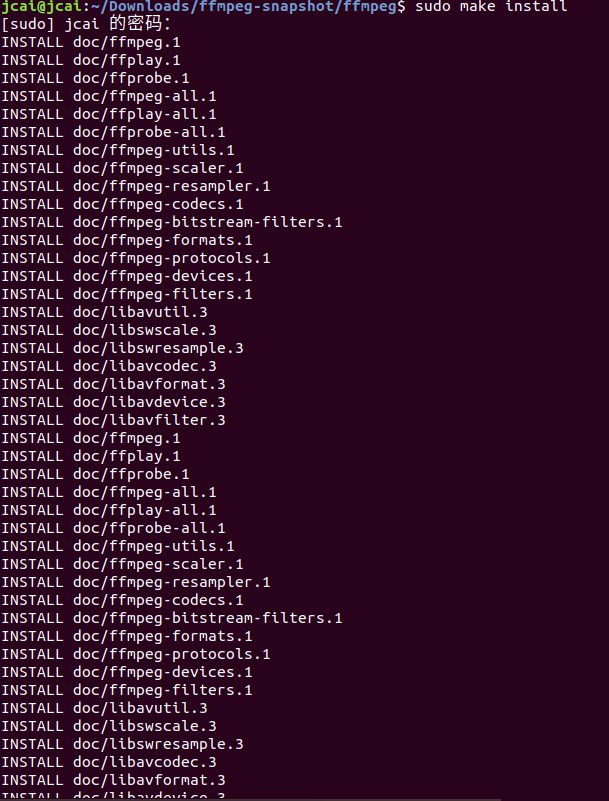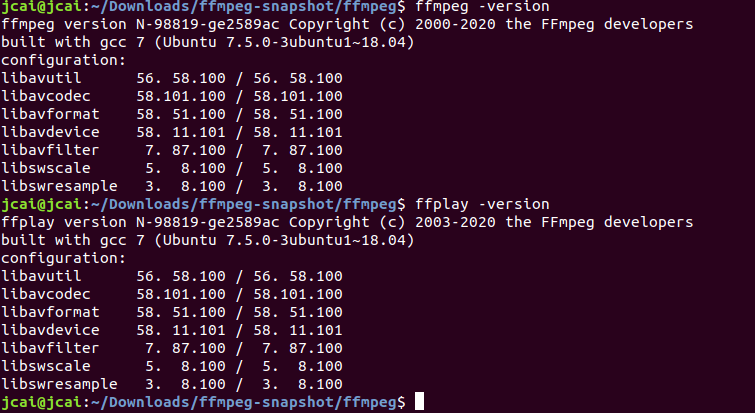詳解Laravel如何安裝FFmpeg并進行視頻文件處理
Ubuntu 18.04 安裝FFmpeg
1、下載源碼編譯安裝
github地址:github.com/PHP-FFMpeg/PHP-FFMpeg
安裝依賴的庫
主要安裝三個:yasm ,sdl1.2 和 sdl2.0
安裝 yasmsudo apt-get install yasm 安裝 sdl1.2sudo apt-get install libsdl1.2-dev 安裝 sdl2.0sudo apt-get install libstdl2-devsudo apt-get install libstdl2-dev
如果sdl2.0 安裝出現(xiàn)錯誤的話可以選擇編譯安裝方式:
官網(wǎng)下載最新版本: www.libsdl.org/download-2.0.php
解壓后進入到目錄中,依次執(zhí)行以下命令:
./configure make sudo make install

編譯安裝ffmpeg
進入ffmpeg文件夾,依次執(zhí)行以下命令:

./configuremakesudo make install
在這里插入圖片描述
測試是否安裝成功
ffmpeg -version ffplay -version

laravel 安裝PHP-FFMpeg擴展
composer require php-ffmpeg/php-ffmpeg
基本使用
1.1、 引入到項目
引入完成,它需要制定 兩個配置文件信息,以便我們正常使用,也就是上文所講的 ffmpeg 和 ffprobe
1.2、全局配置
到 AppServiceProvider.php 中添加代碼
public function boot()
{
$this->registerSingleObject();
}
private function registerSingleObject()
{
// $ffmpeg = FFMpeg::create(array(
// 'ffmpeg.binaries' => '/usr/local/ffmpeg/ffmpeg',
// 'ffprobe.binaries' => '/usr/local/ffmpeg/ffprobe',
// 'timeout' => 3600,
// The timeout for the underlying process
// 'ffmpeg.threads' => 12,
// The number of threads that FFMpeg should use
// ));
$this->app->singleton('ffmpeg', function ($app) {
return FFMpeg::create([
'ffmpeg.binaries' => '/usr/local/ffmpeg/ffmpeg',
'ffprobe.binaries' => '/usr/local/ffmpeg/ffprobe',
]);
});
$this->app->singleton('ffprobe', function ($app) {
return FFProbe::create([
'ffprobe.binaries' => '/usr/local/ffmpeg/ffprobe',
]);
});
}使用單例模式獲取 FFMpeg 和 FFProbe 對象,其中 exec('which ffmpeg') 是獲取 程序位置信息,以便創(chuàng)建類
基礎(chǔ)封裝
舉例:
視頻的第一秒為封面
獲取視頻基礎(chǔ)信息
<?php
namespace AppHelpers;
use FFMpegCoordinateTimeCode;
use IlluminateSupportStr;
class FFMpegUtil{
// 獲取視頻信息
public static function getVideoInfo($streamPath)
{
$ffprobe = app('ffprobe');
$stream = $ffprobe->streams($streamPath)->videos()->first();
return $stream ? $stream->all() : [];
}
// 截取
public static function getCover($streamPath, $fromSecond)
{
$ffmpeg = app('ffmpeg');
$video = $ffmpeg->open($streamPath);
$frame = $video->frame(TimeCode::fromSeconds($fromSecond)); //提取第幾秒的圖像
$fileName = 'video/' . Str::random(12) . '.jpg';
if (!is_dir(storage_path("video"))) {
mkdir(storage_path("video"), 0777);
}
$frame->save(storage_path($fileName));
return $fileName;
}
}業(yè)務(wù)使用
接受 Request 對象傳入的 視頻 為例子
public function saveVideotoQiniu($file){
Auth::loginUsingId(1);
if ($user = getUser()) {
// 1.判斷是否存在此視頻
$path = $file->getRealPath();
$hash = md5_file($path);
$video = Video::firstOrNew(['json->hash' => $hash]);
if ($video->id) {
$video->touch();
return $video;
}
// 2.保存到 云
$cdn_path = $this->saveFile($file);
$db_path = getPath($cdn_path);
// 3.獲取截圖
$fileName = FFMpegUtil::getCover($path, 1);
$image = $this->saveImage(new UploadedFile(storage_path($fileName), 'file.jpg'));
//4.設(shè)置視頻信息
$data = [];
$data = FFMpegUtil::getVideoInfo($path);
$duration = array_get($data, 'duration');
$duration = $duration > 0 ? ceil($duration) : $duration;
$video->path = $db_path;
$video->user_id = $user->id;
$video->setJsonData('width', array_get($data, 'width'));
$video->setJsonData('height', array_get($data, 'height'));
$video->duration = $duration;
$video->setJsonData('cover', $image->path);
$video->save();
}
}例子中的 saveImage 是將圖片上傳到 云端的函數(shù),返回上傳后的圖片 url






